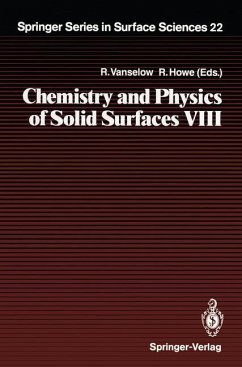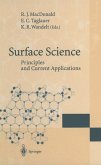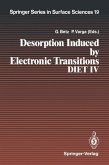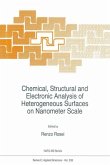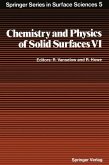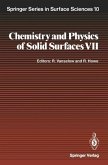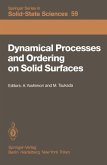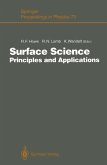Chemistry and Physics of Solid Surfaces VIII
Herausgegeben von Vanselow, Ralf; Howe, Russell
Chemistry and Physics of Solid Surfaces VIII
Herausgegeben von Vanselow, Ralf; Howe, Russell
- Broschiertes Buch
- Merkliste
- Auf die Merkliste
- Bewerten Bewerten
- Teilen
- Produkt teilen
- Produkterinnerung
- Produkterinnerung
This volume contains review articles written by the invited speakers at the ninth International Summer Institute in Surface Science (ISISS 1989), held at the Uni versity of Wisconsin-Milwaukee in August of 1989. During the course of ISISS, invited speakers, all internationally recognized experts in the various fields of surface science, present tutorial review lectures. In addition, these experts are asked to write review articles on their lecture topic. Former ISISS speakers serve as advisors concerning the selection of speakers and lecture topics. Emphasis is given to those areas which have…mehr
Andere Kunden interessierten sich auch für
![Surface Science Surface Science]() Surface Science39,99 €
Surface Science39,99 €![Desorption Induced by Electronic Transitions DIET IV Desorption Induced by Electronic Transitions DIET IV]() Desorption Induced by Electronic Transitions DIET IV77,99 €
Desorption Induced by Electronic Transitions DIET IV77,99 €![Chemical, Structural and Electronic Analysis of Heterogeneous Surfaces on Nanometer Scale Chemical, Structural and Electronic Analysis of Heterogeneous Surfaces on Nanometer Scale]() R. Rosei (ed.)Chemical, Structural and Electronic Analysis of Heterogeneous Surfaces on Nanometer Scale38,99 €
R. Rosei (ed.)Chemical, Structural and Electronic Analysis of Heterogeneous Surfaces on Nanometer Scale38,99 €![Chemistry and Physics of Solid Surfaces VI Chemistry and Physics of Solid Surfaces VI]() Chemistry and Physics of Solid Surfaces VI39,99 €
Chemistry and Physics of Solid Surfaces VI39,99 €![Chemistry and Physics of Solid Surfaces VII Chemistry and Physics of Solid Surfaces VII]() Chemistry and Physics of Solid Surfaces VII39,99 €
Chemistry and Physics of Solid Surfaces VII39,99 €![Dynamical Processes and Ordering on Solid Surfaces Dynamical Processes and Ordering on Solid Surfaces]() Dynamical Processes and Ordering on Solid Surfaces77,99 €
Dynamical Processes and Ordering on Solid Surfaces77,99 €![Surface Science Surface Science]() Surface Science77,99 €
Surface Science77,99 €-
-
-
This volume contains review articles written by the invited speakers at the ninth International Summer Institute in Surface Science (ISISS 1989), held at the Uni versity of Wisconsin-Milwaukee in August of 1989. During the course of ISISS, invited speakers, all internationally recognized experts in the various fields of surface science, present tutorial review lectures. In addition, these experts are asked to write review articles on their lecture topic. Former ISISS speakers serve as advisors concerning the selection of speakers and lecture topics. Emphasis is given to those areas which have not been covered in depth by recent Summer Institutes, as well as to areas which have recently gained in significance and in which important progress has been made. Because of space limitations, no individual volume of Chemistry and Physics of Solid Surfaces can possibly cover the whole area of modern surface science, or even give a complete survey of recent progress in this field. However, an attempt is made to present a balanced overview in the series as a whole. With its comprehensive literature references and extensive subject indices, this series has become a valuable resource for experts and students alike. The collected articles, which stress particularly the gas-solid interface, have been published under the following titles: Surface Science: Recent Progress and Perspectives, Crit. Rev. Solid State Sci.
Produktdetails
- Produktdetails
- Springer Series in Surface Sciences .22
- Verlag: Springer / Springer Berlin Heidelberg / Springer, Berlin
- Artikelnr. des Verlages: 978-3-642-75764-8
- Softcover reprint of the original 1st ed. 1990
- Seitenzahl: 484
- Erscheinungstermin: 6. Dezember 2011
- Englisch
- Abmessung: 235mm x 155mm x 27mm
- Gewicht: 727g
- ISBN-13: 9783642757648
- ISBN-10: 3642757642
- Artikelnr.: 36118709
- Herstellerkennzeichnung Die Herstellerinformationen sind derzeit nicht verfügbar.
- Springer Series in Surface Sciences .22
- Verlag: Springer / Springer Berlin Heidelberg / Springer, Berlin
- Artikelnr. des Verlages: 978-3-642-75764-8
- Softcover reprint of the original 1st ed. 1990
- Seitenzahl: 484
- Erscheinungstermin: 6. Dezember 2011
- Englisch
- Abmessung: 235mm x 155mm x 27mm
- Gewicht: 727g
- ISBN-13: 9783642757648
- ISBN-10: 3642757642
- Artikelnr.: 36118709
- Herstellerkennzeichnung Die Herstellerinformationen sind derzeit nicht verfügbar.
1. Reactivity of Surfaces.- 1.1 Chemisorbed Phases-Alterations of the Substrate Bonds.- 1.2 Chemical Transformation-Alteration of the Adsorbate Bonds.- 1.3 Nonlinear Dynamics in Surface Reactions.- 1.4 Conclusion.- References.- 2. New Mechanisms for the Activation and Desorption of Molecules at Surfaces.- 2.1 Translational Activation of CH4.- 2.2 Collision Induced Dissociative Chemisorption and Collision Induced Desorption of CH4.- 2.3 New Methods for Activation: New Syntheses.- References.- 3. Photochemistry at Adsorbate-Metal Interfaces: Intra-adsorbate Bond Breaking.- 3.1 General Considerations.- 3.2 Experimental Considerations.- 3.3 Examples.- 3.4 Prospects.- References.- 4. Desorption Induced by Electronic Transitions.- 4.1 Mechanisms of DIET.- 4.2 Experimental Procedures for Positive and Negative Ion ESDIAD.- 4.3 DIET Studies of a Model System: PF3 on Ru{0001}.- 4.4 Summary and Conclusions.- References.- 5. Transition Metal Clusters and Isolated Atoms in Zeolite Cages.- 5.1 Preparation of Encaged Particles.- 5.2 Thermodynamic "Driving Forces" Favoring Locations and Particle Morphology.- 5.3 Mechanisms of Metal Particle Formation.- 5.4 Identification of Isolated Atoms and Electron Deficient Particles.- 5.5 Formation of Bimetallic Particles.- 5.6 Summary and Conclusions.- References.- 6. Studies of Bonding and Reaction on Metal Surfaces Using Second-Harmonic and Sum-Frequency Generation.- 6.1 Second-Harmonic Generation.- 6.2 Sum-Frequency Generation.- References.- 7. Surface Physics and Chemistry in High Electric Fields.- 7.1 Electric Fields at Metal Surfaces.- 7.2 Dispersion and Polarization Forces.- 7.3 Field-Induced Chemisorption.- 7.4 Field Evaporation.- 7.5 Thermal Field Desorption.- 7.6 Field-Induced Chemistry.- 7.7 Concluding Remarks.- References.- 8.Chaos in Surface Dynamics.- 8.1 Concepts in Chaos.- 8.2 Examples.- 8.3 Period Doubling.- 8.4 Hamiltonian Systems.- References.- 9. Ten Years of Low Energy Positron Diffraction.- 9.1 Low-Energy Electron Diffraction.- 9.2 The First LEPD Experiments (1979).- 9.3 Brightness Enhancement.- 9.4 Surface Structure Determinations with Modern LEPD: CdSe{1010} and CdSe{1120}.- 9.5 Positron Diffraction at Very Low Energy.- 9.6 Conclusions.- References.- 10. Time-of-Flight Scattering and Recoiling Spectrometry (TOF-SARS) for Surface Analysis.- 10.1 Historical Review.- 10.2 Experimental Method.- 10.3 Examples of Experimental Results.- 10.4 Summary.- References.- 11. Scanning Electron Microscopy with Polarization Analysis: Studies of Magnetic Microstructure.- 11.1 Spin Polarization of Secondary Electrons.- 11.2 Experimental.- 11.3 SEMPA Measurement Examples.- 11.4 Summary and Future Directions.- References.- 12. Low Energy Electron Microscopy.- 12.1 Fundamentals of LEEM.- 12.2 LEEM Studies of Clean Surfaces.- 12.3 LEEM Studies of Surface Layers.- 12.4 Outlook.- 12.5 Summary.- References.- 13. Atomic Scale Surface Characterization with Photoemission of Adsorbed Xenon (PAX).- 13.1 Introduction.- 13.2 Principles of the PAX-Technique.- 13.3 Selected Case Studies of Metallic Surfaces.- 13.4 Summary and Implications.- References.- 14. Theoretical Aspects of Scanning Tunneling Microscopy.- 14.1 General Tunneling Theory.- 14.2 STM Images and their Interpretation.- 14.3 Spectroscopy.- 14.4 Mechanical Interactions Between Tip and Sample.- 14.5 Conclusion.- References.- 15. Proximal Probes: Techniques for Measuring at the Nanometer Scale.- 15.1 Proximal Probes.- 15.2 Nanoscale Fabrication Using Proximal Probes.- 15.3 Conclusion.- References.- 16. Studying Surface Chemistry Atom-by-Atom Using theScanning Tunneling Microscope.- 16.1 Topography and Spectroscopy with the STM.- 16.2 Imaging Semiconductor Surface Chemistry Atom-by-Atom Using the STM.- 16.3 The Structure of the Si{111}-7 × 7 Surface.- 16.4 Site-Selective Reactions of Si{111}-7 × 7.- 16.5 Molecular Adsorption on Si{111}-7 × 7.- 16.6 Reactions That Involve Extensive Atomic Rearrangements.- 16.7 Doping Effects on Silicon Surface Chemistry.- 16.8 Conclusions and Prospects for the Future.- References.- 17. Bonding and Structure on Semiconductor Surfaces.- 17.1 Basic Mechanism Driving Surface Reconstruction.- 17.2 The Geometric and Electronic Structures of GaAs{110}.- 17.3 The GaAs{111}(2 × 2) Surface Reconstruction.- 17.4 Structure of the Si{111}7 × 7 Surface.- 17.5 The Ge{111} c(2 × 8) Reconstruction.- 17.6 Summary.- References.- 18. Tribology at the Atomic Scale.- 18.1 Concepts in Classical Tribology.- 18.2 Experimental Approaches.- 18.3 Theoretical Descriptions of Tribology.- 18.4 Summary and Future Directions.- References.- of Chemistry and Physics of Solid Surfaces IV (Springer Series in Chemical Physics, Vol. 20).- of Chemistry and Physics of Solid Surfaces V (Springer Series in Chemical Physics, Vol. 35).- of Chemistry and Physics of Solid Surfaces VI (Springer Series in Surface Sciences, Vol. 5).- of Chemistry and Physics of Solid Surfaces VII (Springer Series in Surface Sciences, Vol. 10).
1. Reactivity of Surfaces.- 1.1 Chemisorbed Phases-Alterations of the Substrate Bonds.- 1.2 Chemical Transformation-Alteration of the Adsorbate Bonds.- 1.3 Nonlinear Dynamics in Surface Reactions.- 1.4 Conclusion.- References.- 2. New Mechanisms for the Activation and Desorption of Molecules at Surfaces.- 2.1 Translational Activation of CH4.- 2.2 Collision Induced Dissociative Chemisorption and Collision Induced Desorption of CH4.- 2.3 New Methods for Activation: New Syntheses.- References.- 3. Photochemistry at Adsorbate-Metal Interfaces: Intra-adsorbate Bond Breaking.- 3.1 General Considerations.- 3.2 Experimental Considerations.- 3.3 Examples.- 3.4 Prospects.- References.- 4. Desorption Induced by Electronic Transitions.- 4.1 Mechanisms of DIET.- 4.2 Experimental Procedures for Positive and Negative Ion ESDIAD.- 4.3 DIET Studies of a Model System: PF3 on Ru{0001}.- 4.4 Summary and Conclusions.- References.- 5. Transition Metal Clusters and Isolated Atoms in Zeolite Cages.- 5.1 Preparation of Encaged Particles.- 5.2 Thermodynamic "Driving Forces" Favoring Locations and Particle Morphology.- 5.3 Mechanisms of Metal Particle Formation.- 5.4 Identification of Isolated Atoms and Electron Deficient Particles.- 5.5 Formation of Bimetallic Particles.- 5.6 Summary and Conclusions.- References.- 6. Studies of Bonding and Reaction on Metal Surfaces Using Second-Harmonic and Sum-Frequency Generation.- 6.1 Second-Harmonic Generation.- 6.2 Sum-Frequency Generation.- References.- 7. Surface Physics and Chemistry in High Electric Fields.- 7.1 Electric Fields at Metal Surfaces.- 7.2 Dispersion and Polarization Forces.- 7.3 Field-Induced Chemisorption.- 7.4 Field Evaporation.- 7.5 Thermal Field Desorption.- 7.6 Field-Induced Chemistry.- 7.7 Concluding Remarks.- References.- 8.Chaos in Surface Dynamics.- 8.1 Concepts in Chaos.- 8.2 Examples.- 8.3 Period Doubling.- 8.4 Hamiltonian Systems.- References.- 9. Ten Years of Low Energy Positron Diffraction.- 9.1 Low-Energy Electron Diffraction.- 9.2 The First LEPD Experiments (1979).- 9.3 Brightness Enhancement.- 9.4 Surface Structure Determinations with Modern LEPD: CdSe{1010} and CdSe{1120}.- 9.5 Positron Diffraction at Very Low Energy.- 9.6 Conclusions.- References.- 10. Time-of-Flight Scattering and Recoiling Spectrometry (TOF-SARS) for Surface Analysis.- 10.1 Historical Review.- 10.2 Experimental Method.- 10.3 Examples of Experimental Results.- 10.4 Summary.- References.- 11. Scanning Electron Microscopy with Polarization Analysis: Studies of Magnetic Microstructure.- 11.1 Spin Polarization of Secondary Electrons.- 11.2 Experimental.- 11.3 SEMPA Measurement Examples.- 11.4 Summary and Future Directions.- References.- 12. Low Energy Electron Microscopy.- 12.1 Fundamentals of LEEM.- 12.2 LEEM Studies of Clean Surfaces.- 12.3 LEEM Studies of Surface Layers.- 12.4 Outlook.- 12.5 Summary.- References.- 13. Atomic Scale Surface Characterization with Photoemission of Adsorbed Xenon (PAX).- 13.1 Introduction.- 13.2 Principles of the PAX-Technique.- 13.3 Selected Case Studies of Metallic Surfaces.- 13.4 Summary and Implications.- References.- 14. Theoretical Aspects of Scanning Tunneling Microscopy.- 14.1 General Tunneling Theory.- 14.2 STM Images and their Interpretation.- 14.3 Spectroscopy.- 14.4 Mechanical Interactions Between Tip and Sample.- 14.5 Conclusion.- References.- 15. Proximal Probes: Techniques for Measuring at the Nanometer Scale.- 15.1 Proximal Probes.- 15.2 Nanoscale Fabrication Using Proximal Probes.- 15.3 Conclusion.- References.- 16. Studying Surface Chemistry Atom-by-Atom Using theScanning Tunneling Microscope.- 16.1 Topography and Spectroscopy with the STM.- 16.2 Imaging Semiconductor Surface Chemistry Atom-by-Atom Using the STM.- 16.3 The Structure of the Si{111}-7 × 7 Surface.- 16.4 Site-Selective Reactions of Si{111}-7 × 7.- 16.5 Molecular Adsorption on Si{111}-7 × 7.- 16.6 Reactions That Involve Extensive Atomic Rearrangements.- 16.7 Doping Effects on Silicon Surface Chemistry.- 16.8 Conclusions and Prospects for the Future.- References.- 17. Bonding and Structure on Semiconductor Surfaces.- 17.1 Basic Mechanism Driving Surface Reconstruction.- 17.2 The Geometric and Electronic Structures of GaAs{110}.- 17.3 The GaAs{111}(2 × 2) Surface Reconstruction.- 17.4 Structure of the Si{111}7 × 7 Surface.- 17.5 The Ge{111} c(2 × 8) Reconstruction.- 17.6 Summary.- References.- 18. Tribology at the Atomic Scale.- 18.1 Concepts in Classical Tribology.- 18.2 Experimental Approaches.- 18.3 Theoretical Descriptions of Tribology.- 18.4 Summary and Future Directions.- References.- of Chemistry and Physics of Solid Surfaces IV (Springer Series in Chemical Physics, Vol. 20).- of Chemistry and Physics of Solid Surfaces V (Springer Series in Chemical Physics, Vol. 35).- of Chemistry and Physics of Solid Surfaces VI (Springer Series in Surface Sciences, Vol. 5).- of Chemistry and Physics of Solid Surfaces VII (Springer Series in Surface Sciences, Vol. 10).

